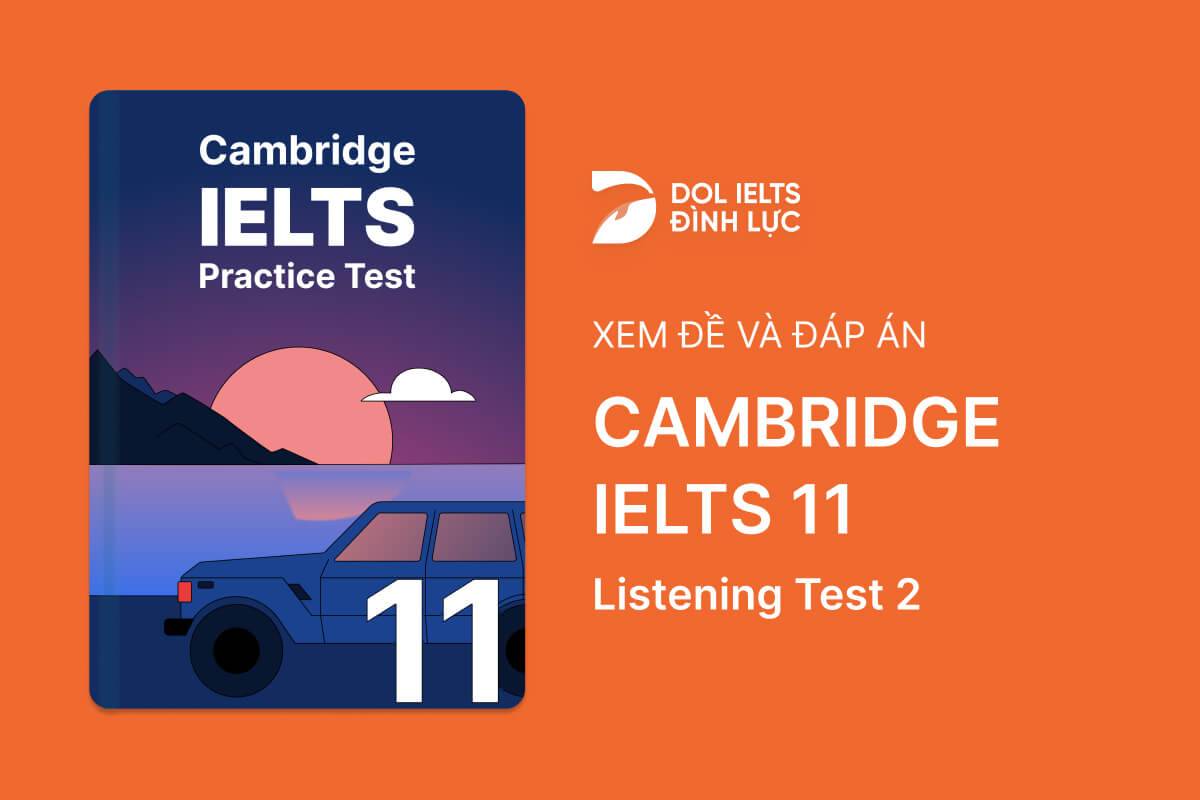Cambridge IELTS 11 - Listening Test 2 With Practice Test, Answers And Explanation
Luyện tập đề IELTS Online Test Cambridge IELTS 11 - Listening Test 2 được lấy từ cuốn sách Cambridge IELTS 11 với trải nghiệm thi IELTS trên máy và giải thích đáp án chi tiết bằng Linearthinking, kèm answer key và list từ vựng IELTS cần học trong bài đọc.
Section
👂️ Bài nghe section 1
❓ Tapescript section 1
🔥 Đáp án & giải thích section 1
Giải thích chi tiết
 Đáp án là một danh từ (sống ở đâu).
Đáp án là một danh từ (sống ở đâu).
=> Bạn cũng để ý có từ currently (hiện tại) tức mình phải tìm nơi mà ông ấy đang sống, không phải đã sống hay có ý định sống trong tương lai.
 Khi official hỏi là "and where do you live, Roger?'' là mình biết đáp án sắp tới.
Khi official hỏi là "and where do you live, Roger?'' là mình biết đáp án sắp tới.
 Tiếp, Roger nói là ''at the moment I'm looking for a flat to live''
Tiếp, Roger nói là ''at the moment I'm looking for a flat to live''
=> Đây là thông tin đánh lạc hướng, bạn có thể điền nhầm là flat bởi bạn nghe thấy at the moment = currently nhưng ý ông ấy nói là hiện tại ông ấy đang tìm, ông ấy chưa sống ở đây
Section
👂️ Bài nghe section 2

❓ Tapescript section 2
🔥 Đáp án & giải thích section 2
Giải thích chi tiết
 Mình cần tìm thông tin về hai thay đổi ở rạp chiếu phim
Mình cần tìm thông tin về hai thay đổi ở rạp chiếu phim
=> Mình sẽ nghe thông tin sau câu ''In fact, as you can see, we're carrying out a major refurbishment at the moment''
 Ở câu đầu tiên, ''the interior has just been repainted''
Ở câu đầu tiên, ''the interior has just been repainted''
=> Đây đúng là một thay đổi nhưng do không có đáp án nào ứng với câu này nên mình bỏ qua.
 Tiếp, ''and we're about to start on the exterior of the building''
Tiếp, ''and we're about to start on the exterior of the building''
Section
👂️ Bài nghe section 3
❓ Tapescript section 3
🔥 Đáp án & giải thích section 3
Giải thích chi tiết
 Câu đầu tiên hỏi về mục tiêu của chuyến đi mà cần thêm vào (should be included in their aims)
Câu đầu tiên hỏi về mục tiêu của chuyến đi mà cần thêm vào (should be included in their aims)
=> Khi Colin nói "Let's look at the aims of the trip first'' là mình biết sắp có đáp án
 Đầu tiên, Colin nói ''I just put something about …''
Đầu tiên, Colin nói ''I just put something about …''
=> Colin đã viết mục tiêu này vào rồi => Loại
 Sau đó, ''But we need something about what causes different organisms to choose particular habitats'' (ứng với đáp án A)
Sau đó, ''But we need something about what causes different organisms to choose particular habitats'' (ứng với đáp án A)
Section
👂️ Bài nghe section 4
Function
Physical and
context31
Symbolic meaning
On the site of a discussed
32
Beside a
33
The design is based on the concept of a mystery
The floor is built on huge pads made of
37
The walls are made of local wood and are
in shape38
Ceiling panels and
on walls allow adjustment of acoustics39
❓ Tapescript section 4
🔥 Đáp án & giải thích section 4
Giải thích chi tiết
 Đáp án mình cần điền là một tính từ (tương tự với physical)
Đáp án mình cần điền là một tính từ (tương tự với physical)
 Theo thứ tự mình sẽ nghe về context sau function và về đáp án sau khi người nói nhắc về physical
Theo thứ tự mình sẽ nghe về context sau function và về đáp án sau khi người nói nhắc về physical
=> Mình biết đáp án sắp tới sau "The second thing the architect needs to think about …'' (Cái thứ hai sau function)
 Đầu tiên, người nói nhắc đến physical, ''this includes its physical location, obviously'' (điều này đương nhiên là bao gồm vị trí vật lý của nó)
Đầu tiên, người nói nhắc đến physical, ''this includes its physical location, obviously'' (điều này đương nhiên là bao gồm vị trí vật lý của nó)
=> Sau đó, ''but it also includes the social meaning of the building'' (nhưng nó cũng bao gồm ý nghĩa xã hội của tòa nhà)


